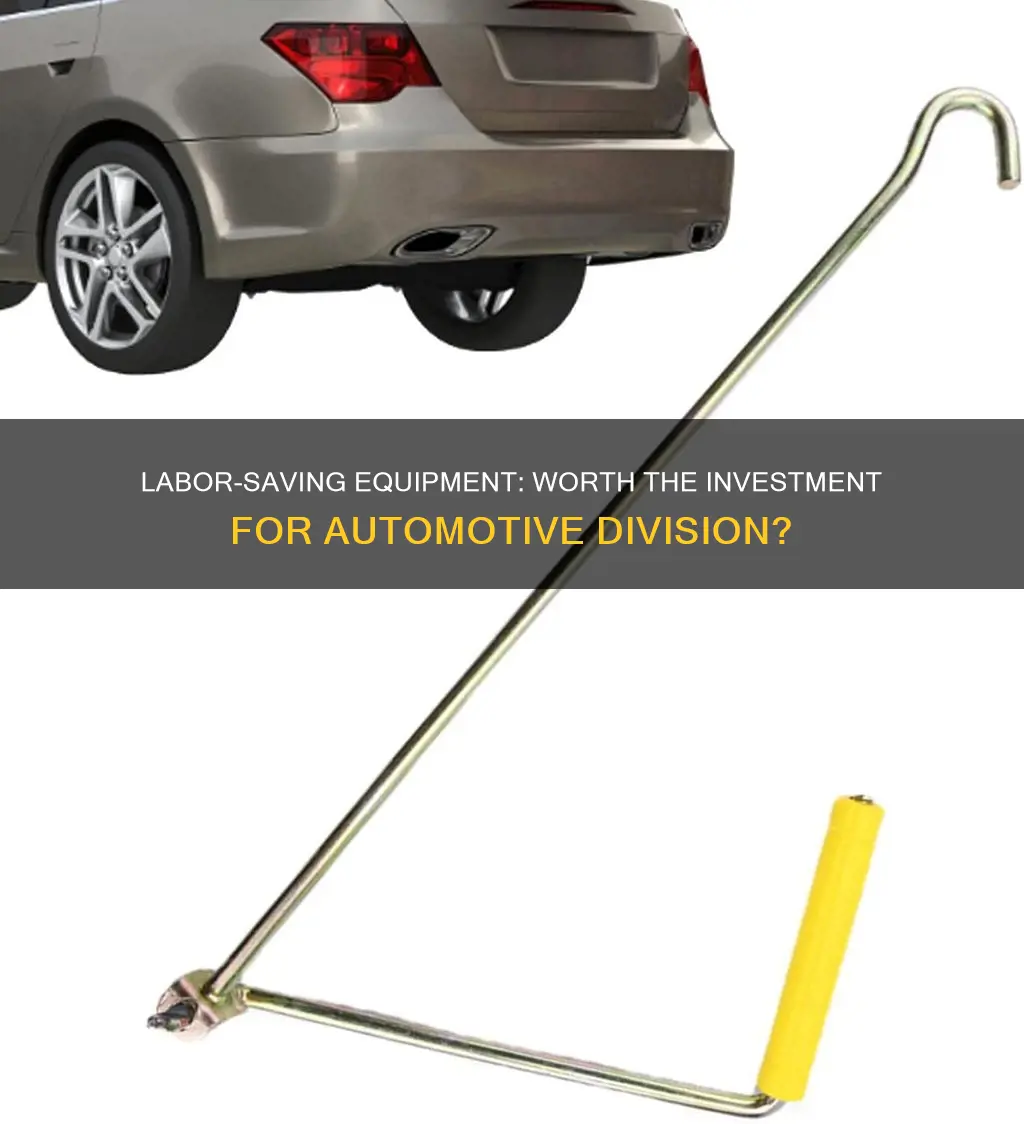
The automotive industry is at a crossroads. The transition to electric vehicles, the rise of automation and artificial intelligence, and a labour shortage are all disrupting the sector. As such, automotive manufacturers and their suppliers are rethinking their strategies to attract and retain talent. This includes investing in labour-saving equipment, such as automation and robotics, to enhance manufacturing efficiency and reduce costs. However, the industry must also consider the potential impact on their workforce, including job security and wage concerns, as well as the need for upskilling and retraining. With these challenges and opportunities in mind, should the automotive division invest in labour-saving equipment?
What You'll Learn

Impact of automation on jobs
Automation has been a part of the automotive industry since the 1960s, with the first industrial robot being installed at a General Motors plant in 1961. Since then, the industry has been at the forefront of automation advancements, with one of the highest numbers of industrial robots installed worldwide.
The impact of automation on jobs in the automotive industry is complex and multifaceted. On the one hand, automation can lead to job losses and layoffs as certain tasks become automated and require less human labour. This is particularly true for routine manual jobs, which are often replaced by robots and other automated systems. The automotive industry is a major user of industrial robots, and this has likely contributed to a decline in middle-skill occupations, such as manufacturing and production jobs.
However, automation can also create new jobs and increase demand for certain types of workers. For example, technicians and other skilled workers may be needed to operate and maintain automated systems. Additionally, automation can lead to an increase in high-skill occupations, such as managerial positions, and low-skill occupations, such as care and service jobs.
The automotive industry is facing a labour shortage, partly due to the "Great Retirement", an exodus of Baby Boomer technicians and labourers, and a reluctance among younger generations to enter the manufacturing industry. Automation can help address this labour shortage by taking on some of the tasks that would otherwise be performed by human workers.
Furthermore, automation can improve working conditions and job satisfaction by reducing the need for strenuous and ergonomically unfavourable tasks. Collaborative robotic solutions, or cobots, can work alongside human workers, improving efficiency and speed without replacing human jobs.
While automation may reduce the overall number of jobs in the automotive industry, it is important to note that it can also create new types of jobs and improve working conditions for those who remain. The impact of automation on jobs is not solely negative, and a combination of human labour and automation is often the most effective approach.
Investing in New York's 529: A College Savings Guide
You may want to see also

Cost-efficiency of labour-saving equipment
Labour costs are a significant expense for any business, and with the automotive industry facing a skills shortage, it is a management priority. Investing in labour-saving equipment can be a cost-efficient way to improve productivity and streamline processes.
The automotive industry has been heavily unionised for decades, with higher labour and administrative costs. However, the industry is changing, with the development of electric vehicles and increasingly sophisticated technology. This shift presents an opportunity for automotive companies to manage costs by preventing unionisation in new plants and managing costs in the supply chain.
One way to improve cost efficiency is to invest in labour-saving equipment. For example, smart" equipment with automated and programmable features can save time and labour. This type of equipment can be easily operated by less skilled workers, reducing training costs and improving efficiency. Additionally, labour-saving equipment can help to offset the increased cleaning requirements due to COVID-19, freeing up staff time for other tasks.
Another benefit of labour-saving equipment is improved consistency. For example, automatic basket lifts on fryers can help provide product consistency by taking the guesswork out of timing. This not only improves the customer experience but can also reduce waste and costs associated with inconsistent production.
Furthermore, labour-saving equipment can improve flexibility. For instance, a combi oven and blast chiller combination can allow for bulk cooking and storage, with the ability to finish dishes to order. This setup enables a more flexible staffing model, where employees can multitask across traditional roles.
Investing in labour-saving equipment can also help address the challenges posed by the "Great Retirement", a term referring to the exodus of Baby Boomer technicians and labourers. With younger generations reluctant to enter the manufacturing industry, labour-saving equipment can help bridge the skills gap and reduce reliance on manual labour.
In conclusion, labour-saving equipment can be a cost-efficient investment for the automotive division. By improving productivity, consistency, and flexibility, while also addressing skills shortages, such equipment can drive significant benefits for automotive companies.
Monthly Savings: Invest Wisely, Grow Your Wealth
You may want to see also

Employee retention and engagement
Building a Positive Culture
A positive, supportive, and inclusive culture is essential for employee retention and engagement. This involves creating an environment based on respect, transparency, and teamwork. Dan Stiles, a director at a staffing agency, suggests that building a culture of employee engagement is vital to attracting top talent and fostering cohesion within the company.
Developing Employee Voice
The automotive industry is facing a lot of uncertainty, making communication critical. Keeping the lines of communication open has two main benefits: it helps leaders understand employee needs and empowers employees. Implementing a digital communication system that gives all employees access to leaders is essential. Additionally, maintaining an open-door policy, conducting regular meetings, and seeking employee feedback through surveys are effective ways to encourage open communication.
Providing Competitive Pay and Benefits
Offering competitive wages and benefits is crucial for retaining employees. This includes monitoring industry trends in pay and benefits and regularly surveying employees to understand their needs. Benefits such as health and prescription drug coverage, mental health support through employee assistance programs, virtual healthcare, accident and serious illness coverage, and disability management services are highly valued by employees.
Offering Opportunities for Advancement
Employees value opportunities for career growth and development within the company. Creating a transparent job structure and org chart can help employees see their advancement paths. Regular conversations between managers and team members to discuss interests and match them with specific training programs or mobility options are beneficial. Mentorship programs can also empower employees and provide them with executive support for their career goals.
Recognizing and Praising Employees
Recognition and praise are essential for making employees feel valued and appreciated. Encouraging innovation, continuous improvement, and creative problem-solving while rewarding these efforts can boost employee morale and engagement.
Providing Work-Life Balance
Employees, especially younger generations, value work-life balance and flexible work arrangements. Offering flexible work options, such as flex time, split shifts, and part-time work, can help attract and retain workers.
Investing in Employee Retention
Employee retention strategies, such as mentorship programs, investing in employee careers, enabling better performance through effective performance management, and getting recognition right, can significantly impact employee engagement and retention.
By implementing these strategies, automotive companies can improve employee retention and engagement, leading to a more productive, satisfied, and loyal workforce.
Invest Wisely: A Guide to Savings in Australia
You may want to see also

Impact on quality and customer experience
Investing in labor-saving equipment can have a significant impact on the quality and customer experience within the automotive division. Here are some ways in which this can be beneficial:
Improved Efficiency and Productivity: Labor-saving equipment can help streamline automotive manufacturing processes, making them more efficient and productive. This can lead to increased output and reduced production times, resulting in improved overall efficiency. For instance, the use of smart" equipment with automated and programmable features can save time on training and daily staffing hours, ultimately benefiting the bottom line.
Enhanced Quality: The use of labor-saving equipment can lead to improved product quality. For example, automated features can ensure consistent results, reducing the potential for human error. This can result in higher-quality vehicles and improved customer satisfaction.
Better Resource Allocation: By investing in labor-saving equipment, automotive companies can free up employee time and resources. This allows workers to focus on more complex or value-added tasks, such as innovation, customer service, or process improvement. This can lead to a more efficient and effective utilization of resources, ultimately improving the customer experience.
Addressing Labor Shortages: The automotive industry currently faces labor shortages due to factors such as the Great Retirement, younger generations opting for other industries, and the increasing intelligence of machinery. Labor-saving equipment can help mitigate these shortages by reducing the overall reliance on human labor. This can result in improved productivity and efficiency, ensuring that production timelines are met without overworking the existing workforce.
Cost Savings: While the initial investment in labor-saving equipment may be significant, it can lead to long-term cost savings. By reducing the reliance on human labor, companies can save on labor costs, including wages and benefits. Additionally, labor-saving equipment can help prevent overtime expenses and reduce training costs by making processes more intuitive and accessible.
The impact of labor-saving equipment on quality and customer experience is multi-faceted. It improves efficiency, enhances product quality, and allows for better resource allocation. Additionally, it helps address labor shortages and can lead to cost savings. By investing in labor-saving equipment, automotive companies can improve their overall operations and deliver a better experience to their customers.
ETFs: Smart Short-Term Investment Strategy for Savings?
You may want to see also

Training and upskilling employees
To address this issue, employers must invest in the development of their current employees by providing training programs and opportunities for upskilling. This includes offering apprenticeships, internships, and access to repair data and tools to stay abreast of technological advancements. Additionally, employers can partner with educational institutions to create initiatives that attract young talent, such as scholarships, apprenticeships, and mentorship programs.
The automotive industry's transition to electric vehicles and the growing influence of automation and artificial intelligence also contribute to the need for upskilling. McKinsey research suggests that established auto companies will need to reskill 25% of their workforce to remain competitive. This includes developing skills in data analytics, digital marketing, software, and IT.
Upskilling employees is not only beneficial for the workers but also for the organizations themselves. It helps organizations retain talent, improve productivity, and adapt to the rapid pace of automation. Furthermore, it is a cost-efficient alternative to hiring new employees, as the cost of replacing an employee can be as high as 150% of their annual salary.
To prepare employees for the future of work, organizations should:
- Secure a commitment to employee development from the top management.
- Project future hiring needs and start building training and recruiting programs accordingly.
- Partner with community colleges and non-traditional education providers to develop a diverse talent pipeline.
- Re-evaluate job requirements to ensure they are not depriving qualified candidates of opportunities.
- Implement thoughtful offboarding programs to support former employees' career pathways.
By investing in talent development initiatives and considering non-traditional candidates, organizations can position themselves for success in the evolving automotive industry.
Investing Young: Better Than Saving?
You may want to see also
Frequently asked questions
Labor-saving equipment can help to reduce training time and daily staffing hours, which in turn can lead to cost savings for the business. It can also help to improve productivity and efficiency, allowing workers to focus on more complex tasks.
Investing in labor-saving equipment may not always result in cost savings, as there can be significant upfront costs associated with purchasing and implementing new technology. Additionally, there may be resistance or skepticism from employees towards automation, particularly if it is seen as a replacement for human labor.
The automotive division can emphasize that labor-saving equipment will not replace human workers but instead complement their skills and help to improve their efficiency. They can also highlight the potential for improved job satisfaction by reducing mundane or repetitive tasks. Additionally, providing training and upskilling opportunities can help employees feel more comfortable with new technology and ensure they have the skills needed to operate it effectively.







